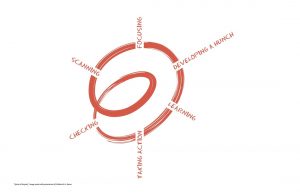I have chosen to share the opening paragraph of my inquiry project so that people can connect with my line of thinking.
Introduction
As we began this inquiry process last term I found myself asking questions surrounding how one would assess if students are learning what is being taught. I was comfortable planning activities and lessons that would be beneficial to the students but I had never assessed or evaluated whether or not those same students learned what I had intended. This led me to realize that it would be very difficult for me to evaluate what each student learned and how comfortable they were with the content. Therefore, it became evident to me that self-assessment would be the key to using my students as resources. As a result, my question became; How can I use formative self-assessment to enhance students’ learning?
I also believed it was important to share my conclusions:
Conclusion
I have learned much about assessment from the professional reading I have been doing, the co-learning from my peers and from the experiences I have had on practicum. I have made an effort to plan meaningful, varied and fair assessment practices into the units I have planned for my extended practicum. While these plans are at this point in time seemingly well defined, I will seek to be reflective and flexible in my assessment practices as my ten-week practicum unfolds. As Halbert & Kaser, 2013 stated, inquiry is a spiraling process which takes multiple turns and revisions. My hope is that I will be able to adapt my assessment practices as I continue to develop as a teacher candidate to better serve the needs of my students, my school and my professional practice. I believe that this project has given me a good starting point, but I will continue to develop my inquiry in the coming months.
For anyone that is interested I have included my references list so that they can engage with my learning through what I read.

References
Alberta. (1993). Principles for fair student assessment practices for education in Canada. Edmonton: The Province.
Allsopp, D. H., McHatton, P. A., & Farmer, J. L. (2010). Technology, mathematics PS/RTI, and students with LD: What do we know, what have we tried, and what can we do to improve outcomes now and in the future? Learning Disability Quarterly, 33(4), 273–288.
Bures, E. M., Barclay, A., Abrami, P. C., & Meyer, E. J. (2013). The reality of assessing “authentic” electronic portfolios: Can electronic portfolios serve as a form of standardized assessment to measure literacy and self-regulated learning at the elementary level? Canadian Journal of Learning and Technology, 39(4).
Davies, A., & Herbst, S. (2013). Co-construction success criteria. Education Canada, 53 (5). Retrieved January 5th, 2014, from: http://www.cea-ace.ca/education-canada/article/co-constructing-success-criteria
Davis, D. S., & Neitzel, C. (2011). A self-regulated learning perspective on middle grades classroom assessment. The Journal of Educational Research, 104, 202-215.
Dweck, C. (2007). Boosting student achievement with messages that motivate. Education Canada, 47, 6- 10.
Garrison, C. & Ehringhaus, M. (n.d.). Formative and summative assessment in the classroom. Retrieved from https://www.amle.org/BrowsebyTopic/WhatsNew/WNDet/TabId/270/ArtMID/888/ArticleID/286/Formative-and-Summative-Assessments-in-the-Classroom.aspx
Halbert, J., & Kaser, L. (2013). Spirals of inquiry for equity and quality. Vancouver, BC; British Columbia Principals’ and Vice-Principals’ Association.
The Hawn Foundation (n.d.). MindUP. Retrieved from http://thehawnfoundation.org/mindup/
Kaftan, J.M., Buck, G.A., & Haack, A. (2006). Using formative assessments to individualize instruction and promote learning. Retrieved from https://www.amle.org/BrowsebyTopic/Assessment/AsDet/TabId/180/ArtMID/780/ArticleID/454/Using-Formative-Assessments-to-Individualize-Instruction-and-Promote-Learning.aspx
Louis, P., & Harada, V.H. (2012). Did students get it? self-assessment as key to learning. School Library Monthly, 29(3), 13-16.
Nicol, D.J., & Macfarlane-Dick, D. (2006). Formative assessment and self-regulated learning: A model and seven principles of good feedback practice. Studies in Higher Education, 31(2), 199-218.
Wanner, T., & Palmer, E. (2015). Personalizing learning: exploring student and teacher perceptions about flexible learning and assessment in a flipped university course. Computers & Education, 88, 354-369.
William, D. (2011). What is assessment for learning?. Studies in Educational Evaluation, 37(1), 3-14.